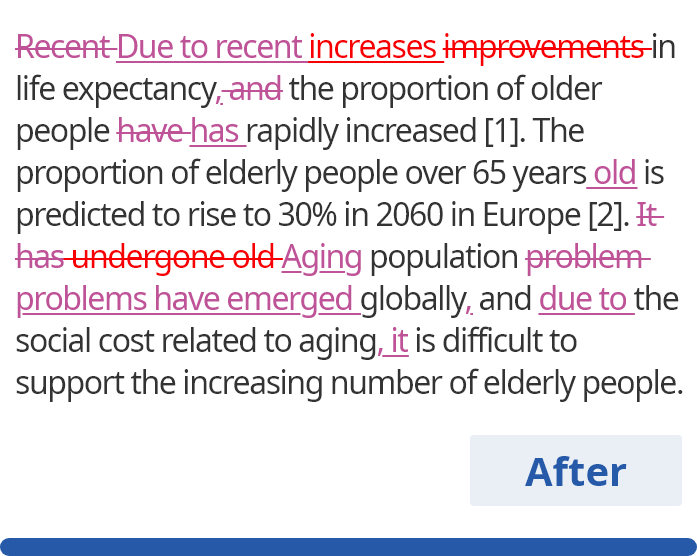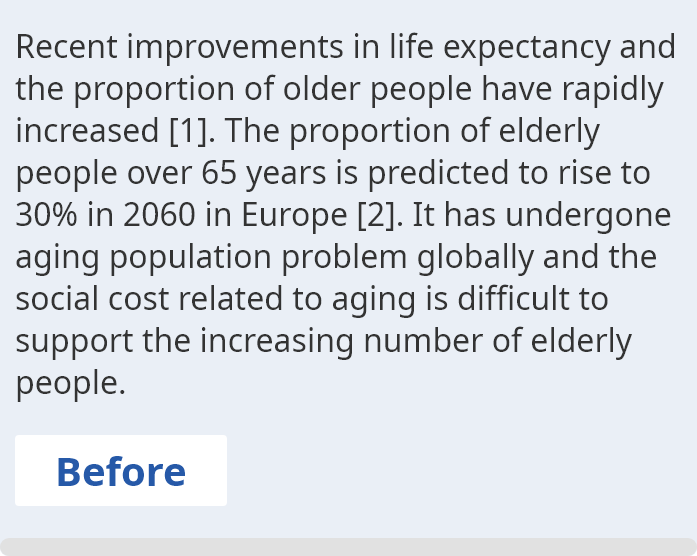形容詞の使い方
形容詞は、名詞や代名詞の属性、数量等の情報を提供する単語です。形容詞にはいくつかの種類がありますが、それらはすべて何かについて説明する役目を果たしています。名詞を修飾する単語であることから、冠詞も形容詞として分類されます。
- Example
- He has a cute puppy.
Wordvice services are helpful.
This movie is my favorite.
形容詞の種類
| 形容詞の種類 | 形容詞の役目 | 例 |
|---|---|---|
| 記述形容詞 |
名詞または代名詞に関する説明 |
We saw a beautiful sunset. |
| 数量形容詞 |
名詞や代名詞の数量に関する情報の提供 |
She brought three bags of chips. |
| 固有形容詞 |
固有名詞の形容詞形態 |
Japanese animations are very popular. |
| 指示形容詞 |
何か、または誰かについて直接的に言及 |
This book is well-written. |
| 所有形容詞 |
所有を表す |
Did you see my pen? |
| 疑問形容詞 |
疑問を表す |
Which song is your favorite? |
| 不定形容詞 |
名詞に関する具体的でない情報の提供 |
He found a few crystals in the cave. |
| 複合形容詞 |
2語以上の組み合わせから成る1つの語彙単位として名詞を修飾 |
The composite is composed of fine-milled filaments. |
記述形容詞
記述形容詞は名詞や代名詞に関する説明をします。このタイプの形容詞は、何かについての追加的情報を提供しています。
- Example
- The girl has a doll.
The girl has a pretty doll.
ここでの「pretty」という単語は記述形容詞で、女の子が持っている人形に関する説明をしています。
- Example
- We used a system to detect the response.
We used an adaptive system to detect the transient response.
多くの場合、記述形容詞は必須情報を伝達します。「A system to detect the response(反応を検出するシステム)」というセンテンスは曖昧で、情報として決して十分とは言えません。「An adaptive system to detect the transient response(過渡反応を検出する適応システム)」にすると具体的になり、情報としてもさらに詳細になります。
数量形容詞
数量形容詞は、名詞の数量に関しての説明をします。その際の数量とは、正確な数値の場合もあります。
- Example
- Bacteria samples were cultivated for the experiment.
Three bacteria samples were cultivated for the experiment.
しかし、数量形容詞には「whole」や「complete」といった語も含まれています。
- Example
- A voltage drop can cause the instrument to malfunction.
A complete voltage drop can cause the instrument to malfunction.
固有形容詞
固有形容詞とは、形容詞の形態で用いられる固有名詞のことを指します。固有名詞は特定の名称であり、常に大文字で始まります。国籍、言語、組織名、学派等はすべ固有名詞に該当します。
- Example
- Korean fried chicken is the tastiest.
- Example
- The admissions officer told me that Harvard classes are rigorous.
- Example
- Did you pick up the French textbook?
「Korean」「Harvard」「French」はすべて固有名詞ですが、上記の文脈ではこれらはすべて形容詞として使われています。
指示形容詞
指示形容詞は、ある名詞に直接的に言及します。
- Example
- This paper proposes a new algorithm that can detect seismic signals.
- Example
- Please be careful; those books are very old.
これら指示形容詞は、言及対象となっている名詞の前に位置します。
- Incorrect
- Star that is the brightest in the sky.
- Correct
- That star is the brightest in the sky.
よく使われる指示形容詞: that, this, those, these
所有形容詞
所有形容詞は、ある特定の名詞を所有・保有している人物を示しています。
- Example
- Our results revealed that a sudden drop in voltage can lead to enhanced performance.
- Example
- He was reading when his brother called him.
指示形容詞と同様に、所有形容詞も、常に言及対象となっている名詞の前に位置します。
- Incorrect
- The results of study their were found to be inaccurate.
- Correct
- The results of their study were found to be inaccurate.
よく使われる所有形容詞: my, your, his, her, our, their, its
疑問形容詞
疑問形容詞は質問を表しています。
- Example
- Whose textbook is that?
- Example
- What is the motivation behind this study?
- Example
- Which sample is the most viable?
質問形容詞は次の3つのみです: what, which, whose
不定形容詞
不定形容詞は、名詞に関する具体的でない情報を提供します。
- Example
- While it is possible to argue for some association between the subgroups, no concrete evidence was found.
上記センテンスにおいて、書き手は、サブグループ間の関係性についての具体的な数値やデータを挙げていません。
- Example
- Every sample was tested for contamination reduction.
- Example
- It was found that most of the subjects were not up to date on their vaccines.
よく使われる不定形容詞: some, every, each, most, several, many
複合形容詞
複合形容詞は、名詞に関する説明をしている単語の組み合わせであることが多く、そういった形容詞の構成要素となっている単語同士はハイフンで結ばれています。
- Example
- We have developed a long-term solution to transient electromagnetic interference.
- Example
- The bitter old man was once a naïve, bright-eyed boy.
複合形容詞は、単語をただ並べたコンビネーションの形を取ることもでき、通常はクォーテーションマークで括られています。この形式がアカデミックライティングで用いられことは多くありませんが、口語体の文脈ではかなりよくみられる形です。
- Example
- She had her hair pulled back into her “I could not be bothered to care” bun.
形容詞の度合い
何かを比較する際、形容詞の形態が変化します。比較には次の3つの度合いがあります。: 原級, 比較級, 最上級。 「bright」という形容詞の例を以下で見てみましょう。
- 原級
- He picked up the bright lamp.
- 比較級
- He picked up the brighter lamp.
- 最上級
- He picked up the brightest lamp.
形容詞によっては、比較級と最上級としての変化形がないものもあります。多くの形容詞の比較級と最上級はそれぞれ「more」「most」という単語を付け加えるだけで形成できます。このような形容詞の例の1つが「brilliant」です。
- 原級
- He is a brilliant student.
- 比較級
- He is a more brilliant student.
- 最上級
- He is the most brilliant student.
アカデミックライティングにおける形容詞の使い方
一般的に、アカデミックライティングはできるだけ簡略でなければなりません。そのため、形容詞はそれ自体が必須な情報である場合にのみ記載することが求められてきます。形容詞を多用するとセンテンスが冗長になりがちで、文脈も複雑化します。
- Example
- We developed a three-dimensional model of the protein gloverin.
ここでの「three-dimensional」は、開発されたモデルに関する必須情報を伝達する複合形容詞です。そのため、この形容詞を省いてしまうと重要な情報が排除されてしまいます。
- Example
- We developed a highly informative three-dimensional computer model of the antibacterial insect protein gloverin.
これは同じセンテンスですが、追加の形容詞が入っています。「Highly informative」と「computer」は、センテンスを少し長めにしているに過ぎず、開発されたモデルに関するより多くの情報を提供している訳ではありません。「antibacterial」と「insect」に関しても同じことが言えます。この形容詞を付け加えたことで、センテンスが必要以上に長くなってしまいます。この2つの形容詞による情報は、別の節で伝達するのがより適切でしょう。
- Example
- We developed a three-dimensional model of gloverin, an antibacterial insect protein that is isolated from silk moth pupae.













